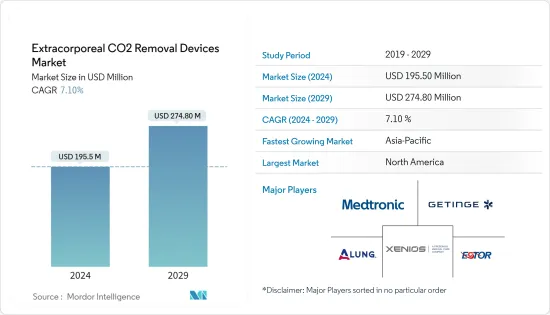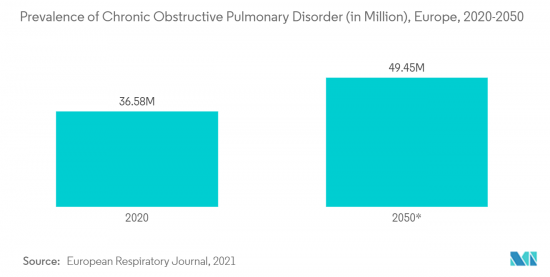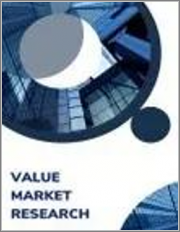
|
시장보고서
상품코드
1406994
세계 체외식 CO2 제거장치 시장 - 점유율 분석, 산업 동향, 통계 및 성장 예측(2024-2029년)Extracorporeal CO2 Removal Devices - Market Share Analysis, Industry Trends & Statistics, Growth Forecasts 2024 - 2029 |
||||||
체외식 CO2 제거장치 시장 규모는 2024년에 1억 9,550만 달러로 추정되며, 2029년까지는 2억 7,480만 달러에 이를 것으로 예측되며, 예측기간 중(2024-2029년) CAGR 7.10%로 성장할 전망입니다.

COVID-19 팬데믹은 체외식 CO2 제거장치 시장의 성장에 영향을 주었습니다. 예를 들어, 2021년 4월에 Lancet Respiratory Medicine에 게재된 조사 연구에 따르면 천식 사람의 중증 COVID-19의 위험은 상대적으로 작지만 COPD와 간질성 폐 질환의 사람은 COVID-19 중증화 위험이 적당히 증가하는 것 같습니다. 따라서 유행은 시장 성장에 영향을 미쳤습니다. 그러나 규제와 무역장벽이 철폐됨에 따라 ECMO 장비공급망이 확대되고 예측 기간 동안 시장 성장이 촉진될 것으로 예상됩니다.
COPD 및 기타 호흡기 질환의 유병률 증가, 제품 출시 및 승인 수 증가 등의 요인이 예측 기간 중 시장 성장을 뒷받침할 것으로 예상됩니다.
만성 폐색성 폐질환(COPD) 및 기타 질병의 유병률 증가는 시장 성장을 가속하는 주요 요인입니다. 예를 들어, 2021년 1월 PLOS ONE에 발표된 연구에 따르면 프랑스에서는 약 260만 명이 COPD를 앓고 있다고 합니다. 2025년에는 이 수가 280만 명으로 증가할 것으로 예상됩니다. 게다가, 2022년에 National Health Science가 발표한 통계에 따르면 영국에서는 2020년부터 2021년에 약 117만명이 COPD로 진단되었으며, 이는 전체 인구의 1.9%를 차지하고 있습니다. 이와 같이 인구에서 COPD의 높은 부담은 혈류를 활성화하고 효율적인 가스교환을 위한 체외식 CO2제거장치 수요를 높여 시장 성장을 가속하고 있습니다.
게다가 기업 활동이 활발해지고 제품 시장 및 제품 승인이 증가함에 따라 시장에서 CO2 제거 장비의 가용성이 높아지고 시장 성장을 가속할 것으로 예상됩니다. 예를 들어, 2021년 11월, ALung Technologies는 최초의 체외식 이산화탄소 제거 장치인 Hemolung 호흡 보조 시스템에 대해 FDA의 de novo 승인을 받았습니다.
새로운 기술은 새로운 환자층과 ECMO 기술을 병원 내 병원 간 반송 모두에 기동적으로 이용할 수 있게 하는 등 유용한 형태로 ECMO 기술의 잠재적 용도의 수가 증가하고 있습니다. 단기 및 장기 ECMO 응용에 이용가능한 장치의 경우, 현저한 기술적 진보가 관찰되었습니다. 생체적합성을 향상시킨 최신의 ECMO 시스템은 소형화되어 휴대가 가능하며, 이 기술을 보다 간단하고 안전한 방법으로 제공할 수 있습니다.
따라서 COPD 및 기타 호흡기 질환의 부담이 크거나 제품 승인이 증가하고 있는 등의 요인으로 인해 ECMO 시장은 예측 기간 동안 성장할 것으로 예상됩니다. 그러나, 체외식 CO2 제거 치료 중 합병증의 위험은 예측 기간 동안 체외식 CO2 제거 장치 시장의 성장을 방해할 가능성이 높습니다.
체외식 CO2 제거장치 시장 동향
만성 폐색성 폐질환(COPD) 부문이 예측 기간 동안 큰 시장 점유율을 차지할 전망
만성 폐색성 폐 질환 부문은 인구의 만성 폐색성 폐 질환 환자 증가와 같은 요인으로 인해 예측 기간 동안 시장에서 큰 성장이 예상됩니다.
European Respiratory Journal에 게재된 논문에 따르면, 2021년 11월 팬데믹에서는 약 3,650만명의 유럽인이 COPD를 앓고 있으며, 이 수는 2050년까지 4,940만명에 달할 것으로 예측되고 있다 합니다. 게다가, 2021년 3월에 Innals of Intensive Care에 게재된 논문에 따르면, COPD 환자를 위한 최신 ECCO2R 장치는 매우 낮은 혈류 속도로 작동하고 최소한의 이중 루멘 캐뉼라를 삽입하기만 하면 됩니다. 따라서 비교적 쉽게 사용할 수 있음이 관찰되었습니다.
게다가 2022년 8월 ERS Journal에 게재된 논문에 따르면 2050년까지 약 6억 4,560만명(남성 4억 5,440만명, 여성 1억 9,120만명)이 COPD에 걸릴 것으로 예측 이는 전 세계 유병률이 전년에 비해 상대적으로 36% 증가함을 보여줍니다. 이와 같이 심각한 공중보건 문제인 COPD의 유병률은 특히 신흥국에서 상승할 것으로 예상되며, 여분의 이산화탄소를 제거하는 효과적인 장치에 대한 수요가 증가할 것으로 예상되므로 이 부문의 성장을 뒷받침합니다.
따라서 위의 요인들로부터 조사 부문은 예측 기간 동안 상당한 성장을 보일 것으로 예상됩니다.

북미가 예측 기간 동안 큰 시장 점유율을 차지할 전망
북미는 COPD, 천식 등 호흡기 질환의 발생률 증가, 정부 이니셔티브 증가, 정비된 건강 관리 시스템의 존재 등의 요인으로 인해 시장 전체에서 큰 점유율을 차지할 것으로 예상됩니다.
인구 사이에서 호흡기 질환의 부담이 증가하고 있는 것이, 이 지역 시장 성장을 가속하는 주요 요인입니다. 예를 들어, 2022년 8월에 NLM에 게재된 논문에 따르면, 급성 호흡 곤란 증후군(ARDS)은 매년 세계에서 300만명, 미국에서 20만명의 중증 환자가 병을 앓고 있는 것으로 확인되었습니다 합니다. 또한 2021년 11월 NLM에 게재된 논문에 따르면 만성호흡기질환(CLRD)은 미국에서 사인의 4위이며 매년 약 1,480만명이 COPD로 진단되며 2,500만명 이상 천식이 발생하고 있습니다.
게다가 정부와 비정부 조직의 노력이 증가함에 따라 전체 수익이 증가하고 있습니다. 예를 들어, CDC의 National Asthma Control Program(NACP)은 천식 환자 교육에 기금을 제공합니다. 이러한 이니셔티브는 천식에 대한 인식을 높이고 천식을 치료하는 흡입기 수요와 채용을 증가시켜 시장 성장을 가속할 가능성이 높습니다.
게다가, 이 지역에서의 건강 관리 지출 증가와 다양한 호흡기 질환에 대한 조사비 증가는 체외식 CO2 제거 장치의 채용에 박차를 가할 것으로 예상됩니다. 이것은 예측 기간 동안이 지역 시장 성장을 가속할 것으로 예상됩니다. 예를 들어 NIH, Estimates of Funding for Various Research, Condition, and Disease Categories(RCDC)에 따르면 2021년 1억 4,400만 달러에 비해 2022년 5월, 미국에서는 COPD, 2022년 연구에 약 1억 5,000만 달러가 지출되었습니다.
게다가 다양한 임상시험을 수행하는 기업 활동 증가는 첨단 호흡기의 개발을 증가시켜 시장 성장에 기여하고 있습니다. 예를 들어, 2021년 3월 ALung Technologies, Inc.는 만성 폐색성 폐 질환의 급성 악화(AE-COPD) 치료를 위한 기계적 환기의 회피 또는 최소화를 연구하는 미국 기반의 무작위 비교 피보탈 시험(RCT)인 VENT-AVOID에 100명의 환자를 등록했습니다.
따라서 호흡기질환의 부담 증가와 기업활동의 활성화는 예측기간에 걸쳐 북미지역 시장을 견인할 것으로 예상됩니다.
체외식 CO2 제거 장치 산업 개요
체외식 CO2제거장치 시장은 다수의 대기업이 존재하기 때문에 경쟁은 적당합니다. 각 회사는 시장에서의 지위를 유지하기 위해 제휴, 파트너십, 계약, 신제품 출시 등 다양한 주요 전략을 채택하고 있습니다. 시장의 주요 기업으로는 Medtronic, Getinge AB, Xenios AG, Alung Technologies, ESTOR SpA 등이 있습니다.
기타 혜택:
- 엑셀 형식 시장 예측(ME) 시트
- 3개월간의 애널리스트 서포트
목차
제1장 서론
- 조사의 전제조건과 시장 정의
- 조사 범위
제2장 조사 방법
제3장 주요 요약
제4장 시장 역학
- 시장 개요
- 시장 성장 촉진요인
- 제품출시수와 승인수 증가
- COPD 및 기타 질환의 유병률 증가
- 시장 성장 억제요인
- 체외식 CO2 제거 요법 중 합병증 위험
- Porter's Five Forces 분석
- 신규 참가업체의 위협
- 구매자/소비자의 협상력
- 공급기업의 협상력
- 대체품의 위협
- 경쟁 기업간 경쟁 관계의 강도
제5장 시장 세분화
- 제품별
- 체외식 CO2장치
- 일회용
- 기타
- 용도별
- 만성 폐색성 폐질환(COPD)
- 급성 호흡 곤란 증후군(ARDS)
- 폐이식 용도
- 기타
- 최종 사용자별
- 병원 및 진료소
- 외래수술센터(ASC)
- 기타
- 지역별
- 북미
- 미국
- 캐나다
- 멕시코
- 유럽
- 독일
- 영국
- 프랑스
- 이탈리아
- 스페인
- 기타 유럽
- 아시아태평양
- 중국
- 일본
- 인도
- 호주
- 한국
- 기타 아시아태평양
- 중동 및 아프리카
- GCC
- 남아프리카
- 기타 중동 및 아프리카
- 남미
- 브라질
- 아르헨티나
- 기타 남미
- 북미
제6장 경쟁 구도
- 기업 프로파일
- Alung Technologies
- ESTOR SPA
- Getinge AB
- Medica Spa
- Medtronic
- X-COR Therapeutics
- Xenios AG
제7장 시장 기회와 앞으로의 동향
JHS 24.01.31
The Extracorporeal CO2 Removal Devices Market size is estimated at USD 195.5 million in 2024, and is expected to reach USD 274.80 million by 2029, growing at a CAGR of 7.10% during the forecast period (2024-2029).
The COVID-19 pandemic impacted the growth of the extracorporeal CO2 removal devices market. For instance, as per the research study published in the Lancet Respiratory Medicine in April 2021, the risk of severe COVID-19 in people with asthma is relatively small, but people with COPD and interstitial lung disease appear to have a modestly increased risk of severe disease due to COVID-19. Thus, the pandemic impacted market growth. However, with removed restrictions and trade barriers, the supply chain of ECMO machines has increased, which is expected to fuel the market growth over the forecast period.
Factors such as the increasing prevalence of COPD and other respiratory diseases, as well as the rising number of product launches and approvals, are expected to boost the market growth over the forecast period.
The increasing prevalence of chronic obstructive pulmonary diseases (COPD) and other diseases is the key factor driving the market growth. For instance, according to the study published in the PLOS ONE journal in January 2021, in France, about 2.6 million people were suffering from COPD. By 2025, that number is expected to rise to 2.8 million. Additionally, according to 2022 statistics published by National Health Science, about 1.17 million people in England were diagnosed with COPD in 2020-21, accounting for 1.9% of the total population. Thus, the high burden of COPD among the population raises the demand for extracorporeal CO2 removal devices for vitalizing blood flow and efficient gas exchange, hence propelling the market growth.
Furthermore, the growing company activities and the growing number of product launches, as well as product approvals, increase the availability of CO2 removal devices in the market, which in turn is anticipated to fuel the market growth. For instance, in November 2021, ALung Technologies received the FDA's de novo clearance for its Hemolung respiratory assist system, the first extracorporeal carbon dioxide removal device.
New technologies are enhancing the number of potential applications for the ECMO technology in useful ways, including new-patient population and the ability to make the ECMO technology mobile for both intra- and inter-hospital transport. For the equipment available for short- and long-term ECMO applications, significant technical advancements have been observed. Modern ECMO systems that have enhanced biocompatibility are miniaturized and portable, and they render the provision of this technique in a simpler and safer way.
Therefore, owing to factors such as the high burden of COPD and other respiratory disorders as well as growing product approvals, the studied market is anticipated to grow over the forecast period. However, the risks of complications during extracorporeal CO2 removal therapy are likely to hinder the growth of the extracorporeal CO2 removal devices market over the forecast period.
Extracorporeal CO2 Removal Devices Market Trends
Chronic Obstructive Pulmonary Disease (COPD) Segment is Expected to Hold a Significant Market Share Over the Forecast Period
The chronic obstructive pulmonary diseases segment is anticipated to witness significant growth in the market over the forecast period owing to factors such as the increasing cases of chronic obstructive pulmonary diseases among the population.
According to an article published in the European Respiratory Journal, in November 2021, about 36.5 million Europeans were suffering from COPD during the pandemic, and this number is projected to reach 49.4 million by 2050. Additionally, according to an article published in the Annals of Intensive Care in March 2021, it was observed that the newest ECCO2R devices for COPD patients were relatively easy to use as they work with very low blood flow rates and just require the insertion of a tiny double-lumen cannula.
Additionally, according to an article published in ERS Journal in August 2022, it was projected that about 645.6 million people (454.4 million men and 191.2 million women) were expected to have COPD by 2050, representing a 36% relative increase in global prevalence as compared to the previous year. Thus, the prevalence of COPD, a serious public health issue, is expected to rise, especially in emerging countries, which is anticipated to increase the demand for effective devices to remove extra carbon dioxide, hence propelling the segment's growth.
Thus, owing to the abovementioned factors, the studied segment is expected to show considerable growth over the forecast period.

North America is Expected to Have the Significant Market Share Over the Forecast Period
North America is expected to hold a significant market share in the overall market owing to the factors such as the increasing incidences of respiratory disorders such as COPD, asthma, and others, the growing government initiatives, and the presence of a well-developed healthcare system.
The growing burden of respiratory disorders among the population is the key factor driving the market growth in the region. For instance, according to an article published in NLM, in August 2022, it has been observed that acute respiratory distress syndrome (ARDS) affects 3 million patients worldwide and 200,000 people in the United States in critical illness settings, every year. Also, an article published in NLM, in November 2021 stated that chronic lower respiratory disease (CLRD) is the fourth leading cause of death in the United States, approximately 14.8 million people are diagnosed with COPD and more than 25 million people have had asthma every year.
Additionally, the rise in the number of initiatives undertaken by government and non-government organizations is increasing the overall revenue. For instance, CDC's National Asthma Control Program (NACP) provides funds for educating asthma-affected patients. Such initiatives are likely to increase awareness about asthma, which will increase the demand as well as the adoption of inhalers treating asthma, thereby propelling the market growth.
Furthermore, the growing healthcare expenditure and the rising research spending on various respiratory diseases in the region are anticipated to fuel the adoption of extracorporeal CO2 removal devices. This is expected to boost the market growth in the region over the forecast period. For instance, according to the NIH, Estimates of Funding for Various Research, Condition, and Disease Categories (RCDC), in May 2022, about USD 150 million was spent on research for COPD, 2022 in the United States as compared to USD 144 million in 2021.
Moreover, the rising company activities in conducting various clinical trials increase the development of advanced respiratory devices which is also contributing to the market growth. For instance, in March 2021, ALung Technologies, Inc. enrolled 100 patients in the United States-based VENT-AVOID, a randomized, controlled pivotal trial (RCT) studying the avoidance or minimization of mechanical ventilation for the treatment of acute exacerbations of chronic obstructive pulmonary disease (AE-COPD).
Therefore, the rising burden of respiratory diseases and increasing company activities are expected to drive the market in the North American region over the forecast period.
Extracorporeal CO2 Removal Devices Industry Overview
The extracorporeal Co2 removal devices market is moderately competitive due to the presence of several major players. The companies are adopting various key strategies such as collaborations, partnerships, agreements, and new product launches to retain their position in the market. Some of the key companies in the market include Medtronic, Getinge AB, Xenios AG, Alung Technologies, and ESTOR SpA.
Additional Benefits:
- The market estimate (ME) sheet in Excel format
- 3 months of analyst support
TABLE OF CONTENTS
1 INTRODUCTION
- 1.1 Study Assumptions and Market Definition
- 1.2 Scope of the Study
2 RESEARCH METHODOLOGY
3 EXECUTIVE SUMMARY
4 MARKET DYNAMICS
- 4.1 Market Overview
- 4.2 Market Drivers
- 4.2.1 Rising Numbers of Product Launches and Approvals
- 4.2.2 Increasing Prevalence of COPD and Other Diseases
- 4.3 Market Restraints
- 4.3.1 Risks of Complications During Extracorporeal CO2 Removal Therapy
- 4.4 Porter's Five Forces Analysis
- 4.4.1 Threat of New Entrants
- 4.4.2 Bargaining Power of Buyers/Consumers
- 4.4.3 Bargaining Power of Suppliers
- 4.4.4 Threat of Substitute Products
- 4.4.5 Intensity of Competitive Rivalry
5 MARKET SEGMENTATION (Market Size by Value - USD million)
- 5.1 By Product
- 5.1.1 Extracorporeal CO2 Devices
- 5.1.2 Disposables
- 5.1.3 Others
- 5.2 By Application
- 5.2.1 Chronic Obstructive Pulmonary Disease (COPD)
- 5.2.2 Acute Respiratory Distress Syndrome (ARDS)
- 5.2.3 Bridge to Lung Transplant
- 5.2.4 Others
- 5.3 By End User
- 5.3.1 Hospitals and Clinics
- 5.3.2 Ambulatory Surgical Centers
- 5.3.3 Others
- 5.4 Geography
- 5.4.1 North America
- 5.4.1.1 United States
- 5.4.1.2 Canada
- 5.4.1.3 Mexico
- 5.4.2 Europe
- 5.4.2.1 Germany
- 5.4.2.2 United Kingdom
- 5.4.2.3 France
- 5.4.2.4 Italy
- 5.4.2.5 Spain
- 5.4.2.6 Rest of Europe
- 5.4.3 Asia-Pacific
- 5.4.3.1 China
- 5.4.3.2 Japan
- 5.4.3.3 India
- 5.4.3.4 Australia
- 5.4.3.5 South Korea
- 5.4.3.6 Rest of Asia-Pacific
- 5.4.4 Middle East and Africa
- 5.4.4.1 GCC
- 5.4.4.2 South Africa
- 5.4.4.3 Rest of Middle East and Africa
- 5.4.5 South America
- 5.4.5.1 Brazil
- 5.4.5.2 Argentina
- 5.4.5.3 Rest of South America
- 5.4.1 North America
6 COMPETITIVE LANDSCAPE
- 6.1 Company Profiles
- 6.1.1 Alung Technologies
- 6.1.2 ESTOR S.P.A
- 6.1.3 Getinge AB
- 6.1.4 Medica Spa
- 6.1.5 Medtronic
- 6.1.6 X-COR Therapeutics
- 6.1.7 Xenios AG














